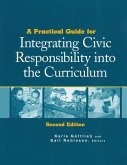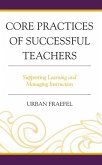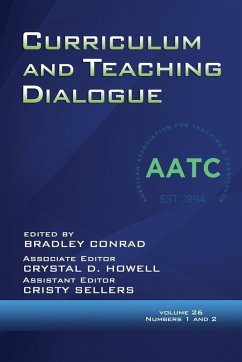- Broschiertes Buch
- Merkliste
- Auf die Merkliste
- Bewerten Bewerten
- Teilen
- Produkt teilen
- Produkterinnerung
- Produkterinnerung
Curriculum at Your Core is a practical guide to designing curriculum that meets standards, serves personal and institutional values, and intentionally leads to successful student learning.
Andere Kunden interessierten sich auch für
![Curriculum at Your Core Curriculum at Your Core]() Lauren PorosoffCurriculum at Your Core61,99 €
Lauren PorosoffCurriculum at Your Core61,99 €![Practical Guide for Integrating Civic Responsibility into the Curriculum Practical Guide for Integrating Civic Responsibility into the Curriculum]() Practical Guide for Integrating Civic Responsibility into the Curriculum22,99 €
Practical Guide for Integrating Civic Responsibility into the Curriculum22,99 €![Core Practices of Successful Teachers Core Practices of Successful Teachers]() Urban FraefelCore Practices of Successful Teachers91,99 €
Urban FraefelCore Practices of Successful Teachers91,99 €![Core Practices of Successful Teachers Core Practices of Successful Teachers]() Urban FraefelCore Practices of Successful Teachers41,99 €
Urban FraefelCore Practices of Successful Teachers41,99 €![Curriculum and Teaching Dialogue Volume 26, Numbers 1 & 2, 2024 Curriculum and Teaching Dialogue Volume 26, Numbers 1 & 2, 2024]() B ConradCurriculum and Teaching Dialogue Volume 26, Numbers 1 & 2, 202468,99 €
B ConradCurriculum and Teaching Dialogue Volume 26, Numbers 1 & 2, 202468,99 €![Lessons in School Improvement from Sub-Saharan Africa Lessons in School Improvement from Sub-Saharan Africa]() Miriam MasonLessons in School Improvement from Sub-Saharan Africa61,99 €
Miriam MasonLessons in School Improvement from Sub-Saharan Africa61,99 €![Advancing Teacher Education and Curriculum Development through Study Abroad Programs Advancing Teacher Education and Curriculum Development through Study Abroad Programs]() Advancing Teacher Education and Curriculum Development through Study Abroad Programs178,99 €
Advancing Teacher Education and Curriculum Development through Study Abroad Programs178,99 €-
-
-
Curriculum at Your Core is a practical guide to designing curriculum that meets standards, serves personal and institutional values, and intentionally leads to successful student learning.
Produktdetails
- Produktdetails
- Verlag: Rowman & Littlefield Publishers
- Seitenzahl: 164
- Erscheinungstermin: 8. Oktober 2014
- Englisch
- Abmessung: 254mm x 178mm x 9mm
- Gewicht: 322g
- ISBN-13: 9781475813111
- ISBN-10: 1475813112
- Artikelnr.: 41124062
- Herstellerkennzeichnung
- Libri GmbH
- Europaallee 1
- 36244 Bad Hersfeld
- gpsr@libri.de
- Verlag: Rowman & Littlefield Publishers
- Seitenzahl: 164
- Erscheinungstermin: 8. Oktober 2014
- Englisch
- Abmessung: 254mm x 178mm x 9mm
- Gewicht: 322g
- ISBN-13: 9781475813111
- ISBN-10: 1475813112
- Artikelnr.: 41124062
- Herstellerkennzeichnung
- Libri GmbH
- Europaallee 1
- 36244 Bad Hersfeld
- gpsr@libri.de
Lauren Porosoff has been a teacher for 14 years, has served as a diversity coordinator and a grade-level team leader, and has led a school-wide curriculum mapping initiative. She regularly supports teachers and administrators in crafting assignments, designing curriculum review processes, and planning professional development.
Curriculum at Your Core: Meaningful Teaching in the Age of Standards
Preface: The Values That Guided This Book
Acknowledgments: The Evolution of a Values-Congruent Book
Introduction: Why Values?
Curriculum That Serves Multiple Sets of ValuesA Place at the Table: Your
Values and the StandardsUsing This BookChapter 1: Clarifying the Values
that Guide Your Teaching
Why Values?What Values Are (and Aren't)A Place at the Table: Your Values
and the StandardsClarifying Your Values as a TeacherMaking Values
StatementsRendering Values from Academic DocumentsAvoiding Your
ValuesBarriers to Teaching By Your ValuesGetting Stuck in Self-Limiting
BeliefsAvoiding Uncomfortable FeelingsDisregarding What Matters
MostExternal FactorsJust NoticingChapter 2: Designing Curriculum Using
Multiple Sets of Values
Teachers' Values vs. Students' ValuesLearning What Your Students
ValueTeachers' Values vs. Other Teachers' ValuesValues Clarification for
GroupsTeachers' Values vs. Institutional ValuesWorking with Institutional
ValuesAccounting for Multiple Sets of ValuesChapter 3: Using Values to
Focus Units
The Unity of a UnitRingmasters and DroversMaking Titles MatterEssential or
Valued?What Essential Questions Sound LikeFrom Values to Essential
QuestionsChapter 4: Organizing Lessons in a Values-Congruent Unit
GatheringChoosing What to Include -- and What to Let GoBeginning a Unit
with What's FamiliarIntroducing New MaterialChoosing Instructional
MethodsCreating Meaningful Contexts for Student WorkProjectsCycles of
Instruction, Practice, and ApplicationRegularly Returning to What
MattersUsing the CalendarMaking a Lesson CalendarMaking AdjustmentsChapter
5: Values-Congruent Assessments
Kinds of Assessment Tasks"Values-Dense" AssessmentsStudents Choosing How
They're AssessedWhen and How Often to Give AssessmentsHelping Students
Reach Outcomes You ValueProvide Multiple Models of Excellent Work for
Students to AnalyzeTeach All the Skills Students Need to Do WellAllow Class
Time for Students to Reach Your Expected Level of QualityModify Assignments
to Fit Students' NeedsWriting Assignment GuidelinesConsider What to Define
and What to Leave Open-EndedSet Yourself Up to Give Values-Congruent
GradesCopy Valued Expectations from Assignment to AssignmentLook for the
Impact of Unintended BiasProject-Based Assessments and ValuesAdjusting Some
MoreChapter 6: Aligning a Unit
A Values-Aligned UnitResistance to AlignmentGetting AlignedCommon Problems
in Aligning a UnitProblem: When the Lessons and Assessment Don't Match the
Essential QuestionProblem: When the Teacher Values Knowledge or Skills but
Doesn't Explicitly Teach ThemProblem: When the Assessment Task Measures
What's Easy to Measure Instead of the Valued UnderstandingsProblem: When
Teachers Assume Students Will Construct Valued Understandings for
ThemselvesProblem: When the Essential Question Seems So Important That the
Unit Goes On Too LongAssessing Your UnitChapter 7: Designing a
Values-Congruent Course
Courses as HeapsOngoing StrandsCourse-Level Essential QuestionsDesigning a
Meaningful Assessment MixMore Factors in Creating an Assessment
MixMediaGroup SizeLocationsStakesCharting an Assessment MixSequencing Your
CourseCreating Balance Between Competing ValuesBuilding On Students'
Existing Knowledge and Skill SetsCreating a Progression of IdeasUpcycling
Student WorkThinking Flexibly About SequenceAssessing Your CourseChapter 8:
Optimizing Your Students' Experience
Gaps in the CurriculumMaking a Values Map of a ProgramRepetitions in the
CurriculumOptimizing the CurriculumProgrammatic Assessment MixesRemoving
Barriers to Optimizing the CurriculumValues ConflictsIntegrating Diverse
ValuesWriting Programmatic Essential QuestionsMapping Values in the
ProgramSeeking Multiple Valued PracticesChapter 9: Connecting Disciplines
Using Values
Finding ConnectionsWhen Good Cross-Disciplinary Efforts Go
BadCross-Disciplinary Essential QuestionsUsing Cross-Disciplinary Essential
QuestionsOverly Broad Essential QuestionsTwo Kinds of Cross-Disciplinary
UnitsOrganizing a Multi-Class UnitBegin with a Shared ExperienceCreate a
Multi-Class ProjectRefer Frequently to the Essential QuestionMake an
Adjustable Unit CalendarMulti-Class AssessmentsGetting Colleagues
InterestedOvercoming Logistical BarriersGoing for ItChapter 10: Increasing
Values Congruence Over Time
The Evolution of a Values-Congruent UnitUnintended ConsequencesShifting
PrioritiesChanging TimesAction ResearchCritical Friends
GroupsValues-Congruent Professional DevelopmentSetting
GoalsSpecificMeaningfulActiveRealisticTime-LimitedThe Teacher You Want to
BeBibliography
Index
Preface: The Values That Guided This Book
Acknowledgments: The Evolution of a Values-Congruent Book
Introduction: Why Values?
Curriculum That Serves Multiple Sets of ValuesA Place at the Table: Your
Values and the StandardsUsing This BookChapter 1: Clarifying the Values
that Guide Your Teaching
Why Values?What Values Are (and Aren't)A Place at the Table: Your Values
and the StandardsClarifying Your Values as a TeacherMaking Values
StatementsRendering Values from Academic DocumentsAvoiding Your
ValuesBarriers to Teaching By Your ValuesGetting Stuck in Self-Limiting
BeliefsAvoiding Uncomfortable FeelingsDisregarding What Matters
MostExternal FactorsJust NoticingChapter 2: Designing Curriculum Using
Multiple Sets of Values
Teachers' Values vs. Students' ValuesLearning What Your Students
ValueTeachers' Values vs. Other Teachers' ValuesValues Clarification for
GroupsTeachers' Values vs. Institutional ValuesWorking with Institutional
ValuesAccounting for Multiple Sets of ValuesChapter 3: Using Values to
Focus Units
The Unity of a UnitRingmasters and DroversMaking Titles MatterEssential or
Valued?What Essential Questions Sound LikeFrom Values to Essential
QuestionsChapter 4: Organizing Lessons in a Values-Congruent Unit
GatheringChoosing What to Include -- and What to Let GoBeginning a Unit
with What's FamiliarIntroducing New MaterialChoosing Instructional
MethodsCreating Meaningful Contexts for Student WorkProjectsCycles of
Instruction, Practice, and ApplicationRegularly Returning to What
MattersUsing the CalendarMaking a Lesson CalendarMaking AdjustmentsChapter
5: Values-Congruent Assessments
Kinds of Assessment Tasks"Values-Dense" AssessmentsStudents Choosing How
They're AssessedWhen and How Often to Give AssessmentsHelping Students
Reach Outcomes You ValueProvide Multiple Models of Excellent Work for
Students to AnalyzeTeach All the Skills Students Need to Do WellAllow Class
Time for Students to Reach Your Expected Level of QualityModify Assignments
to Fit Students' NeedsWriting Assignment GuidelinesConsider What to Define
and What to Leave Open-EndedSet Yourself Up to Give Values-Congruent
GradesCopy Valued Expectations from Assignment to AssignmentLook for the
Impact of Unintended BiasProject-Based Assessments and ValuesAdjusting Some
MoreChapter 6: Aligning a Unit
A Values-Aligned UnitResistance to AlignmentGetting AlignedCommon Problems
in Aligning a UnitProblem: When the Lessons and Assessment Don't Match the
Essential QuestionProblem: When the Teacher Values Knowledge or Skills but
Doesn't Explicitly Teach ThemProblem: When the Assessment Task Measures
What's Easy to Measure Instead of the Valued UnderstandingsProblem: When
Teachers Assume Students Will Construct Valued Understandings for
ThemselvesProblem: When the Essential Question Seems So Important That the
Unit Goes On Too LongAssessing Your UnitChapter 7: Designing a
Values-Congruent Course
Courses as HeapsOngoing StrandsCourse-Level Essential QuestionsDesigning a
Meaningful Assessment MixMore Factors in Creating an Assessment
MixMediaGroup SizeLocationsStakesCharting an Assessment MixSequencing Your
CourseCreating Balance Between Competing ValuesBuilding On Students'
Existing Knowledge and Skill SetsCreating a Progression of IdeasUpcycling
Student WorkThinking Flexibly About SequenceAssessing Your CourseChapter 8:
Optimizing Your Students' Experience
Gaps in the CurriculumMaking a Values Map of a ProgramRepetitions in the
CurriculumOptimizing the CurriculumProgrammatic Assessment MixesRemoving
Barriers to Optimizing the CurriculumValues ConflictsIntegrating Diverse
ValuesWriting Programmatic Essential QuestionsMapping Values in the
ProgramSeeking Multiple Valued PracticesChapter 9: Connecting Disciplines
Using Values
Finding ConnectionsWhen Good Cross-Disciplinary Efforts Go
BadCross-Disciplinary Essential QuestionsUsing Cross-Disciplinary Essential
QuestionsOverly Broad Essential QuestionsTwo Kinds of Cross-Disciplinary
UnitsOrganizing a Multi-Class UnitBegin with a Shared ExperienceCreate a
Multi-Class ProjectRefer Frequently to the Essential QuestionMake an
Adjustable Unit CalendarMulti-Class AssessmentsGetting Colleagues
InterestedOvercoming Logistical BarriersGoing for ItChapter 10: Increasing
Values Congruence Over Time
The Evolution of a Values-Congruent UnitUnintended ConsequencesShifting
PrioritiesChanging TimesAction ResearchCritical Friends
GroupsValues-Congruent Professional DevelopmentSetting
GoalsSpecificMeaningfulActiveRealisticTime-LimitedThe Teacher You Want to
BeBibliography
Index
Curriculum at Your Core: Meaningful Teaching in the Age of Standards
Preface: The Values That Guided This Book
Acknowledgments: The Evolution of a Values-Congruent Book
Introduction: Why Values?
Curriculum That Serves Multiple Sets of ValuesA Place at the Table: Your
Values and the StandardsUsing This BookChapter 1: Clarifying the Values
that Guide Your Teaching
Why Values?What Values Are (and Aren't)A Place at the Table: Your Values
and the StandardsClarifying Your Values as a TeacherMaking Values
StatementsRendering Values from Academic DocumentsAvoiding Your
ValuesBarriers to Teaching By Your ValuesGetting Stuck in Self-Limiting
BeliefsAvoiding Uncomfortable FeelingsDisregarding What Matters
MostExternal FactorsJust NoticingChapter 2: Designing Curriculum Using
Multiple Sets of Values
Teachers' Values vs. Students' ValuesLearning What Your Students
ValueTeachers' Values vs. Other Teachers' ValuesValues Clarification for
GroupsTeachers' Values vs. Institutional ValuesWorking with Institutional
ValuesAccounting for Multiple Sets of ValuesChapter 3: Using Values to
Focus Units
The Unity of a UnitRingmasters and DroversMaking Titles MatterEssential or
Valued?What Essential Questions Sound LikeFrom Values to Essential
QuestionsChapter 4: Organizing Lessons in a Values-Congruent Unit
GatheringChoosing What to Include -- and What to Let GoBeginning a Unit
with What's FamiliarIntroducing New MaterialChoosing Instructional
MethodsCreating Meaningful Contexts for Student WorkProjectsCycles of
Instruction, Practice, and ApplicationRegularly Returning to What
MattersUsing the CalendarMaking a Lesson CalendarMaking AdjustmentsChapter
5: Values-Congruent Assessments
Kinds of Assessment Tasks"Values-Dense" AssessmentsStudents Choosing How
They're AssessedWhen and How Often to Give AssessmentsHelping Students
Reach Outcomes You ValueProvide Multiple Models of Excellent Work for
Students to AnalyzeTeach All the Skills Students Need to Do WellAllow Class
Time for Students to Reach Your Expected Level of QualityModify Assignments
to Fit Students' NeedsWriting Assignment GuidelinesConsider What to Define
and What to Leave Open-EndedSet Yourself Up to Give Values-Congruent
GradesCopy Valued Expectations from Assignment to AssignmentLook for the
Impact of Unintended BiasProject-Based Assessments and ValuesAdjusting Some
MoreChapter 6: Aligning a Unit
A Values-Aligned UnitResistance to AlignmentGetting AlignedCommon Problems
in Aligning a UnitProblem: When the Lessons and Assessment Don't Match the
Essential QuestionProblem: When the Teacher Values Knowledge or Skills but
Doesn't Explicitly Teach ThemProblem: When the Assessment Task Measures
What's Easy to Measure Instead of the Valued UnderstandingsProblem: When
Teachers Assume Students Will Construct Valued Understandings for
ThemselvesProblem: When the Essential Question Seems So Important That the
Unit Goes On Too LongAssessing Your UnitChapter 7: Designing a
Values-Congruent Course
Courses as HeapsOngoing StrandsCourse-Level Essential QuestionsDesigning a
Meaningful Assessment MixMore Factors in Creating an Assessment
MixMediaGroup SizeLocationsStakesCharting an Assessment MixSequencing Your
CourseCreating Balance Between Competing ValuesBuilding On Students'
Existing Knowledge and Skill SetsCreating a Progression of IdeasUpcycling
Student WorkThinking Flexibly About SequenceAssessing Your CourseChapter 8:
Optimizing Your Students' Experience
Gaps in the CurriculumMaking a Values Map of a ProgramRepetitions in the
CurriculumOptimizing the CurriculumProgrammatic Assessment MixesRemoving
Barriers to Optimizing the CurriculumValues ConflictsIntegrating Diverse
ValuesWriting Programmatic Essential QuestionsMapping Values in the
ProgramSeeking Multiple Valued PracticesChapter 9: Connecting Disciplines
Using Values
Finding ConnectionsWhen Good Cross-Disciplinary Efforts Go
BadCross-Disciplinary Essential QuestionsUsing Cross-Disciplinary Essential
QuestionsOverly Broad Essential QuestionsTwo Kinds of Cross-Disciplinary
UnitsOrganizing a Multi-Class UnitBegin with a Shared ExperienceCreate a
Multi-Class ProjectRefer Frequently to the Essential QuestionMake an
Adjustable Unit CalendarMulti-Class AssessmentsGetting Colleagues
InterestedOvercoming Logistical BarriersGoing for ItChapter 10: Increasing
Values Congruence Over Time
The Evolution of a Values-Congruent UnitUnintended ConsequencesShifting
PrioritiesChanging TimesAction ResearchCritical Friends
GroupsValues-Congruent Professional DevelopmentSetting
GoalsSpecificMeaningfulActiveRealisticTime-LimitedThe Teacher You Want to
BeBibliography
Index
Preface: The Values That Guided This Book
Acknowledgments: The Evolution of a Values-Congruent Book
Introduction: Why Values?
Curriculum That Serves Multiple Sets of ValuesA Place at the Table: Your
Values and the StandardsUsing This BookChapter 1: Clarifying the Values
that Guide Your Teaching
Why Values?What Values Are (and Aren't)A Place at the Table: Your Values
and the StandardsClarifying Your Values as a TeacherMaking Values
StatementsRendering Values from Academic DocumentsAvoiding Your
ValuesBarriers to Teaching By Your ValuesGetting Stuck in Self-Limiting
BeliefsAvoiding Uncomfortable FeelingsDisregarding What Matters
MostExternal FactorsJust NoticingChapter 2: Designing Curriculum Using
Multiple Sets of Values
Teachers' Values vs. Students' ValuesLearning What Your Students
ValueTeachers' Values vs. Other Teachers' ValuesValues Clarification for
GroupsTeachers' Values vs. Institutional ValuesWorking with Institutional
ValuesAccounting for Multiple Sets of ValuesChapter 3: Using Values to
Focus Units
The Unity of a UnitRingmasters and DroversMaking Titles MatterEssential or
Valued?What Essential Questions Sound LikeFrom Values to Essential
QuestionsChapter 4: Organizing Lessons in a Values-Congruent Unit
GatheringChoosing What to Include -- and What to Let GoBeginning a Unit
with What's FamiliarIntroducing New MaterialChoosing Instructional
MethodsCreating Meaningful Contexts for Student WorkProjectsCycles of
Instruction, Practice, and ApplicationRegularly Returning to What
MattersUsing the CalendarMaking a Lesson CalendarMaking AdjustmentsChapter
5: Values-Congruent Assessments
Kinds of Assessment Tasks"Values-Dense" AssessmentsStudents Choosing How
They're AssessedWhen and How Often to Give AssessmentsHelping Students
Reach Outcomes You ValueProvide Multiple Models of Excellent Work for
Students to AnalyzeTeach All the Skills Students Need to Do WellAllow Class
Time for Students to Reach Your Expected Level of QualityModify Assignments
to Fit Students' NeedsWriting Assignment GuidelinesConsider What to Define
and What to Leave Open-EndedSet Yourself Up to Give Values-Congruent
GradesCopy Valued Expectations from Assignment to AssignmentLook for the
Impact of Unintended BiasProject-Based Assessments and ValuesAdjusting Some
MoreChapter 6: Aligning a Unit
A Values-Aligned UnitResistance to AlignmentGetting AlignedCommon Problems
in Aligning a UnitProblem: When the Lessons and Assessment Don't Match the
Essential QuestionProblem: When the Teacher Values Knowledge or Skills but
Doesn't Explicitly Teach ThemProblem: When the Assessment Task Measures
What's Easy to Measure Instead of the Valued UnderstandingsProblem: When
Teachers Assume Students Will Construct Valued Understandings for
ThemselvesProblem: When the Essential Question Seems So Important That the
Unit Goes On Too LongAssessing Your UnitChapter 7: Designing a
Values-Congruent Course
Courses as HeapsOngoing StrandsCourse-Level Essential QuestionsDesigning a
Meaningful Assessment MixMore Factors in Creating an Assessment
MixMediaGroup SizeLocationsStakesCharting an Assessment MixSequencing Your
CourseCreating Balance Between Competing ValuesBuilding On Students'
Existing Knowledge and Skill SetsCreating a Progression of IdeasUpcycling
Student WorkThinking Flexibly About SequenceAssessing Your CourseChapter 8:
Optimizing Your Students' Experience
Gaps in the CurriculumMaking a Values Map of a ProgramRepetitions in the
CurriculumOptimizing the CurriculumProgrammatic Assessment MixesRemoving
Barriers to Optimizing the CurriculumValues ConflictsIntegrating Diverse
ValuesWriting Programmatic Essential QuestionsMapping Values in the
ProgramSeeking Multiple Valued PracticesChapter 9: Connecting Disciplines
Using Values
Finding ConnectionsWhen Good Cross-Disciplinary Efforts Go
BadCross-Disciplinary Essential QuestionsUsing Cross-Disciplinary Essential
QuestionsOverly Broad Essential QuestionsTwo Kinds of Cross-Disciplinary
UnitsOrganizing a Multi-Class UnitBegin with a Shared ExperienceCreate a
Multi-Class ProjectRefer Frequently to the Essential QuestionMake an
Adjustable Unit CalendarMulti-Class AssessmentsGetting Colleagues
InterestedOvercoming Logistical BarriersGoing for ItChapter 10: Increasing
Values Congruence Over Time
The Evolution of a Values-Congruent UnitUnintended ConsequencesShifting
PrioritiesChanging TimesAction ResearchCritical Friends
GroupsValues-Congruent Professional DevelopmentSetting
GoalsSpecificMeaningfulActiveRealisticTime-LimitedThe Teacher You Want to
BeBibliography
Index








